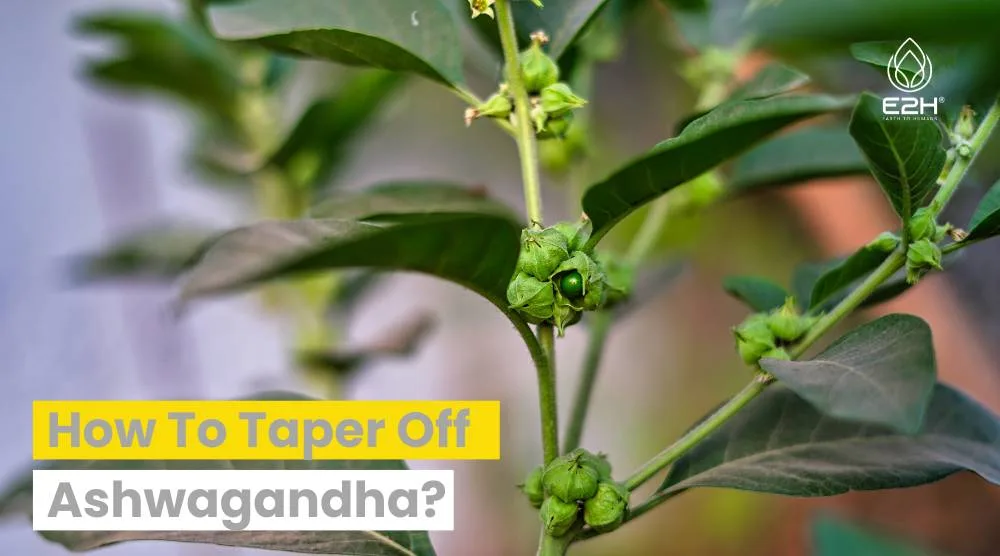How To Taper Off Ashwagandha: To taper off Ashwagandha, gradually reduce your dosage over several weeks, monitoring your body’s response to avoid withdrawal symptoms.
For a comprehensive guide on safely reducing Ashwagandha and managing any potential withdrawal effects, continue reading. Our step-by-step approach ensures a smoother transition for your well-being.
How Can You Handle Ashwagandha Withdrawal Symptoms?
- Gradual Reduction of Dosage: Slowly decrease the amount of Ashwagandha you take. This gradual process helps your body adjust and can minimize withdrawal symptoms.
- Stay Hydrated: Drinking plenty of water can help alleviate some withdrawal symptoms.
- Balanced Diet: Eating a nutritious diet supports your body during the withdrawal phase.
- Regular Exercise: Engaging in physical activity can improve mood and reduce stress, which may be heightened during withdrawal.
- Rest and Sleep: Ensure you get adequate rest. Sleep helps in healing and managing stress.
- Mindfulness and Relaxation Techniques: Practices like meditation, yoga, or deep breathing exercises can be beneficial in managing stress and anxiety symptoms.
- Support System: Lean on friends and family for support. Sharing your experiences can provide emotional relief.

What Are The Common Reasons For Wanting To Taper Off Ashwagandha?
- Side Effects: Some individuals may experience side effects like stomach upset, diarrhea, or headaches.
- Long-Term Use Concerns: People may want to stop after using it for an extended period, either due to personal preference or concerns about long-term effects.
- Pregnancy or Breastfeeding: Women may choose to taper off during pregnancy or while breastfeeding.
- Interactions with Medications: Ashwagandha can interact with certain medications, prompting a need to discontinue its use.
- Health Condition Changes: Changes in health conditions might require stopping the supplement.
- Personal Health Goals: Some individuals might want to stop as their health goals or preferences change.
- Lack of Efficacy: If Ashwagandha isn’t providing the desired benefits, one might decide to stop using it.
When Do Ashwagandha Withdrawal Symptoms Peak And Subside?
Ashwagandha withdrawal symptoms typically begin within a few days to a week after stopping the supplement. The intensity of these symptoms can vary based on factors like the duration of use and the dosage. Commonly, symptoms may peak around the second week, manifesting as increased anxiety, irritability, or physical discomforts like headaches and fatigue.
Gradually, these symptoms start to subside over the following weeks. By the third or fourth week, many individuals begin to notice a significant reduction in symptoms, with most returning to their baseline state. It’s important to remember that the experience of withdrawal can differ from person to person.
What Expert Strategies Help Manage Ashwagandha Withdrawal?
Managing Ashwagandha withdrawal effectively involves several expert strategies. Firstly, a gradual reduction in dosage is crucial. This method allows the body to adjust slowly, reducing the shock of withdrawal. Incorporating a balanced diet and staying hydrated are also key components.
These ensure the body has the necessary nutrients and hydration to cope with the changes. Regular physical exercise is another effective strategy, as it helps in reducing stress and improving mood, which can be particularly beneficial during withdrawal periods.
Additionally, practicing relaxation techniques like meditation or yoga can significantly alleviate symptoms of anxiety and stress. Lastly, having a support system in place, such as friends or family members who understand the process, can provide emotional support and encouragement, making the withdrawal phase more manageable.
Is Ashwagandha Withdrawal A Myth Or A Reality?
Ashwagandha withdrawal is a reality, though it may not be as common or severe as withdrawal from certain other substances. While Ashwagandha is generally considered safe and beneficial for many, discontinuing its use after prolonged periods can lead to withdrawal symptoms in some individuals. These symptoms can include anxiety, irritability, headaches, and fatigue. The occurrence and intensity of these symptoms can vary based on factors like the duration of use, dosage, and individual sensitivity.
It’s important to note that while these withdrawal symptoms are typically mild compared to those associated with pharmaceutical drugs, they are nonetheless a real and documented phenomenon. This underscores the importance of understanding and respecting the effects of natural supplements like Ashwagandha on the body.
Is Ashwagandha A Two-sided Remedy With Potential Drawbacks?
Ashwagandha, while celebrated for its health benefits, indeed has a two-sided nature with potential drawbacks. Known for reducing stress, enhancing energy, and improving concentration, it’s a popular herbal supplement in Ayurvedic medicine. However, its use is not without risks. Some individuals may experience side effects such as stomach upset, diarrhea, or headaches.

In rare cases, more severe reactions like liver issues can occur, especially with high doses or prolonged use. Additionally, Ashwagandha can interact with certain medications and is not recommended for pregnant or breastfeeding women. This duality highlights the importance of using Ashwagandha judiciously, being aware of both its benefits and potential risks.
Can You Recognize Subtle Signs Of Ashwagandha Withdrawal?
- Mild Anxiety or Irritability: A slight increase in feelings of anxiety or irritability can be a sign of withdrawal.
- Headaches: Experiencing headaches, which were not common before, can indicate withdrawal.
- Fatigue: Feeling unusually tired or experiencing a drop in energy levels.
- Difficulty Sleeping: Changes in sleep patterns, such as insomnia, can be a subtle sign.
- Digestive Issues: Experiencing stomach discomfort or changes in bowel movements.
- Mood Swings: Unexplained changes in mood or emotional state.
- Concentration Difficulties: Finding it harder to focus or concentrate than usual.
Why Does Gradual Reduction Matter For Health When Tapering Off Ashwagandha?
Gradual reduction is crucial when tapering off Ashwagandha to maintain health and well-being. Abruptly stopping the intake of Ashwagandha can shock the body, potentially leading to withdrawal symptoms like headaches, anxiety, and sleep disturbances. Gradually reducing the dosage allows the body to adjust to lower levels of the supplement, minimizing these adverse effects.
This approach also respects the body’s natural balance and avoids sudden changes that can disrupt physiological processes. Furthermore, a gradual reduction helps in understanding how the body responds to lower doses of Ashwagandha, providing insights into individual tolerance and the supplement’s impact on overall health.
What’s The Balanced Perspective On Ashwagandha Benefits And Risks?
- Stress Reduction: Ashwagandha is known for its ability to lower stress levels.
- Improved Sleep: It can aid in better sleep quality.
- Enhanced Cognitive Function: Some studies suggest it improves concentration and memory.
- Risks for Pregnant Women: Not recommended during pregnancy due to potential risks.
- Digestive Side Effects: Possible stomach upset, diarrhea, or nausea.
- Drug Interactions: Can interact with certain medications, altering their effectiveness.
- Long-term Use Concerns: Potential issues with prolonged use, such as hormonal imbalances.
- Individual Sensitivity: Effects can vary greatly depending on the individual’s sensitivity and health condition.
How Can You Safely Navigate Challenges When Reducing Ashwagandha Intake?
Safely navigating the challenges of reducing Ashwagandha intake involves a mindful and structured approach. Begin by gradually lowering the dosage, rather than stopping abruptly, to allow your body to adjust. Pay attention to how your body responds to each reduction. If you notice withdrawal symptoms, consider slowing down the tapering process.
Maintaining a healthy lifestyle, including a balanced diet and regular exercise, can support your body during this transition. Additionally, incorporating stress-reduction techniques such as meditation or yoga can be beneficial. It’s also helpful to keep a journal to track your progress and any changes in how you feel, which can provide valuable insights into your body’s response to the reduced intake.
How Do You Create A Personalized Guide For Tapering Off Ashwagandha?
Creating a personalized guide for tapering off Ashwagandha involves understanding your unique health profile and reasons for taking the supplement. Start by assessing the current dosage and duration of your Ashwagandha intake. Based on this, develop a gradual reduction plan, decreasing the dose in small increments over a period of weeks or months.
Monitor your body’s response to each reduction, adjusting the pace as needed. Consider factors like your daily routine, dietary habits, and stress levels, as these can influence the tapering process. Keeping a daily log of your symptoms and overall well-being can help you make informed adjustments. Remember, the goal is to minimize discomfort while safely reducing dependence on the supplement.
How Do Tapering-off Strategies Vary For Different Health Goals Or Conditions?
Tapering-off strategies for Ashwagandha can vary significantly depending on individual health goals or conditions. For instance, someone using Ashwagandha for stress relief might taper off more quickly than someone using it for chronic anxiety, who may require a slower approach to manage potential rebound anxiety.

Individuals with underlying health conditions, like hormonal imbalances or digestive issues, might need to adjust their tapering schedule to account for these factors. The duration of use also plays a role; long-term users typically need a more gradual tapering process compared to short-term users.
Additionally, the presence of other supplements or medications can influence the tapering strategy, as it’s important to consider potential interactions and cumulative effects. Tailoring the tapering-off process to individual needs and circumstances ensures a safer and more effective transition.
FAQs
What is the safest way to reduce Ashwagandha dosage?
Gradually decrease the dose over several weeks, allowing your body to adjust to the change.
Can lifestyle changes assist in tapering off Ashwagandha?
Yes, a balanced diet, regular exercise, and stress management techniques can support the process.
What should I do if I experience withdrawal symptoms?
Slow down the tapering process and ensure adequate rest and hydration.
Is it necessary to monitor health changes while tapering off Ashwagandha?
Yes, monitoring health changes helps in adjusting the tapering schedule as needed.
Can I stop taking Ashwagandha abruptly?
It’s not recommended, as gradual tapering helps prevent withdrawal symptoms.
Conclusion
Tapering off Ashwagandha is a journey that requires patience and attentiveness to your body’s needs. Remember, the key is to go slowly and listen to your body. With the right approach, you can successfully reduce your dependence on Ashwagandha, maintaining your health and well-being throughout the process. Stay positive and trust in your ability to navigate this change smoothly.














